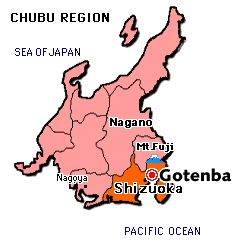


The city of Gotenba is located at the eastern edge of Shizuoka Prefecture. It's surrounded on three sides by volcanoes, the biggest one being Mt. Fuji, and sits approximately 500 meters above sea level. Slightly more than 80,000 people live in an area measuring 194.6 square kilometers.
The name Gotenba comes from the fact that a temporary goten (palace) was built there in 1617 to house the body of Tokugawa Ieyasu, the founder of the Edo shogunate, while it was being moved from its original burial site on Mt. Kuno--120 kilometers southwest of the city--to the mausoleum in Nikko, where it's entombed today.The city has long been famous as the place where climbers start their ascent of Mt. Fuji. Because it's relatively cool in the summer, vacationers have been lured there to escape the heat of the larger surrounding cities. In 1969 the Tomei Expressway linking Tokyo and Nagoya opened to traffic, and an exit was built within the city limits. Since then Gotenba has developed as a popular resort city.
One of its biggest sightseeing assets are the tunnels of Komakado, created during one of Mt. Fuji's eruptions. Registered as a natural monument by the national government, the tunnels continue for 291 meters, with their diameter ranging from 1.2 meters to 10 meters. There are also tributary tunnels that are as long as 110 meters.
When Mt. Fuji erupted in 1707, the lava that spewed out created another tunnel. This tunnel measures 155 meters long and has also been designated as a national natural monument.
Because the soil contains a lot of volcanic ash, it's not suitable for agriculture. Most farmers in the city of Gotenba, therefore, make a living raising chickens, pigs, or mountain vegetables. The city is also home to a number of manufacturers of high-precision equipment and automobile parts.